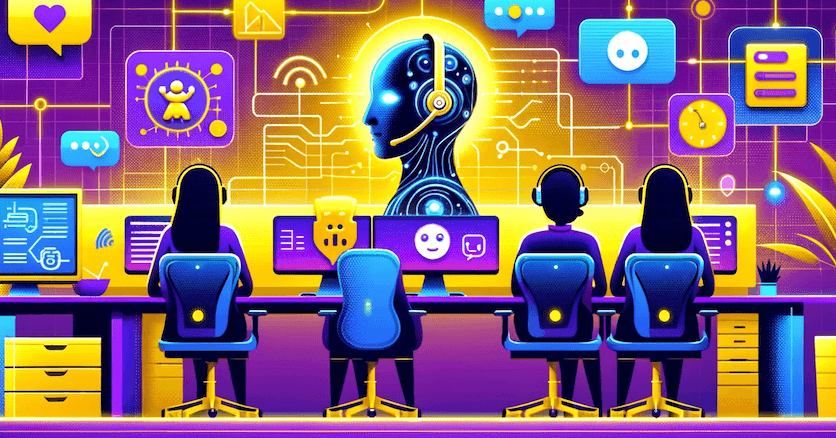10 Key Benefits of Adopting an AI Service Desk
With generative AI solutions like Gleen AI, you can upload your entire IT support knowledge base, automatically answer most employee IT questions, integrate with your help desk software. And, Gleen AI doesn't hallucinate.

Introduction
Artificial Intelligence plays a vital role as a capable assistant in today's technology-driven world. One of its applications is Generative AI, which holds significant promise.
Generative AI offers great possibilities for businesses, and one standout opportunity is making AI-powered service desk support more efficient.
This article explores the benefits of using an AI service desk and offers insights into how it operates. It also outlines important factors to consider when selecting an AI service desk.
What is a service desk?
A service desk is crucial for large corporations, especially in the IT department. Its primary role is to assist employees with their AI IT service desk issues.
When employees face computer or IT-related problems, service desk software helps the IT team provide solutions and support.
Service desk software monitors and registers each issue, including assigned personnel and resolution status. In addition, service desk software can include self-service options.
For example, a support knowledge base allows employees to search support documentation to find an answer to their problem.
Additionally, service desk software can include chatbots. Chatbots are software applications that interact with employees with human-like conversations.
What is Generative AI?
Generative AI is a new form of AI where computers create their own content like text, photos, and videos.
In text generative AI, we train Large Language Models (LLMs) on vast volumes of content available on the internet.
LLMs can generate relevant text by understanding patterns and structures in the language.
Below are the two key benefits of Large Language Models(LLM):
1. They enable machines to learn the context and purpose behind a human's question. When you ask an LLM something, it doesn't just look at individual words but comprehends the meaning behind the question.
2. LLMs empower machines to generate responses that mimic human language. This ability to imitate human-like responses improves communication between machines and humans, making interactions more neutral and effective.
Famous examples of Large Language Models (LLMs) include GPT-3.5 and GPT-4 from Open AI, Claude from Anthropic, and Llama 2 from Meta.
Language Models (LLMs) play a crucial role in revolutionizing the interaction between machines and humans.
Typically, LLMs collaborate closely with chatbots such as ChatGPT. The process unfolds as follows:
Users enter a question or statement into the chatbot. The chatbot conveys both the question and the entire conversation context to the LLM. The LLM then generates a fitting response.
How does a generative AI service desk work?
AI service desk software functions by training a generative AI chatbot on your company's IT support stack.
This means feeding it knowledge about all the enterprise applications, hardware, and software used within the organization.
The chatbot links to your employee support channels like email, Slack, Discord, and live chat. It can also receive and answer user queries.
Also, integration with the IT ticketing system is essential. If the chatbot encounters an issue it can't resolve, it automatically generates a ticket.
This ticket notifies your IT team to help with any unresolved problems that need immediate attention.
Benefits of a Generative AI Service Desk
Here is a list of 10 key benefits of a generative AI service desk:
(1) Faster Response Time
An AI powered service desk ensures swift responses to user queries, reducing wait times and improving overall efficiency.
(2) 24/7/365 Availability
A generative AI in service desk is always available, providing support 24/7, unlike human IT teams.
(3) Faster Time to Resolution
Faster response times often lead to faster mean time to resolution.
(4) Multilingual Support
With the ability to understand multiple languages, the service desk AI bot facilitates global communication and assists employees worldwide.
(5) No FAQ Maintenance
There is no need to maintain a list of frequently asked queries with a generative AI service desk. Simply upload your knowledge base, and the AI in service desk will do everything else.
(6) User-Friendly Interface
A generative AI service desk is easy to use. Employees can pose questions without any training, making the AI service desk accessible to everyone.
(7) Empathetic Understanding
Recognizing employee frustration, the AI for the service desk replies with empathy. This results in a more positive and supportive employee experience.
(8) Natural Conversational Style
Responses from the AI service desk mimic natural conversation, promoting a smooth interaction between employees and the system.
(9) Increased Employee Satisfaction
Efficient and user-friendly, the generative AI in service desk contributes to higher levels of employee satisfaction with IT support services.
(10) IT Team Focus
By answering routine queries, the AI service desk frees up the IT team to concentrate on more complex and strategic IT challenges.
7 Key Criteria for Selecting a Generative AI Service Desk
When evaluating AI service desk solutions, be sure to view these seven key criteria:
(1) Knowledge Ingestion Capability
The AI powered service desk should be able to collect data from a variety of sources. Your support knowledge base resolved IT tickets, and vendor knowledge bases are examples of these sources.
(2) No Hallucination
Check if the generative AI service desk avoids hallucination, ensuring that responses are reliable. A hallucination occurs when the AI generates misleading information.
For example, Gleen AI is excellent at avoiding hallucinations. Gleen AI's technology identifies and suppresses hallucinations in more than 80% of cases.
Here's a demonstration of Gleen AI and a custom GPT trained on the same data. Gleen AI does not hallucinate, but the custom GPT does.
Schedule a demo of Gleen AI or build a generative AI chatbot for free with Gleen AI.
(3) Data Security & Confidentiality
Confirm if the AI-powered service desk guarantees the security of your proprietary knowledge and protects sensitive information from unauthorized access.
(4) Automatic Knowledge Base Updates
The knowledge base of the AI service desk should automatically update. Automatic updates will help the knowledge base stay current with frequent IT changes.
(5) Observability
Enrsure the generative service desk AI chatbot doesn't just act like black box.
All questions asked and replies generated should be reviewable by a service desk admin.
(6) Feedback & Continuous Improvement
Check if the generative AI service desk allows employees and administrators to provide feedback. This ensures continuous improvement in responses.
(7) Integration with Existing Service Desk Solutions
Your generative AI should integrate seamlessly with your existing service desk solution. Specifically:
• It should be possible to transfer the entire discussion to live support engineers.
• It should be able to create tickets in your service desk solution beyond business hours.
• When workers request follow-up assistance with an existing issue, they should be able to refer to current service desk tickets.
Conclusion
A generative AI for service desk looks to be an effective option, providing rapid replies, increased productivity, and increased user happiness.
Knowledge intake, security, and ease of integration should all be aspects of AI for service desk. It should also be free of hallucinations.
To experience the next level of AI-driven support, use Gleen AI to power your service desk.
Ask for a Gleen AI demonstration or build a generative AI chatbot at no cost with Gleen AI.



